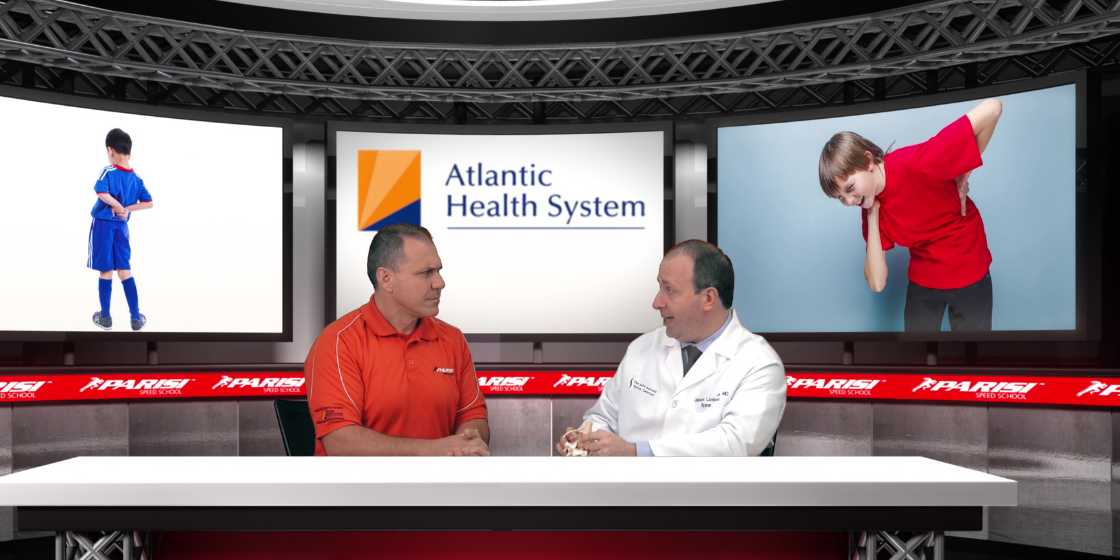“Spondylolisthesis vs. Spondylolysis” with Dr. Jason Lowenstein
In this brief interview, Dr. Jason Lowenstein, Director of Scoliosis & Spinal Deformity for the Atlantic Health System, explains the difference between spondylolisthesis vs. spondylolysis to Bill Parisi, founder of the Parisi Speed School. Spondylolisthesis (aka, a slipped vertebra) and spondylolysis (aka, a fractured vertebra) are two conditions that tend to co-occur in pediatric athletes. In fact, statistics suggest that as many as 1 in 10 children may become affected by this condition.
Are you worried that your child may be suffering from spondylolisthesis or spondylolysis? If so, then contact our pediatric spine experts at The Advanced Spine Center today. Dr. Lowenstein and his team of board-certified spine surgeons use only the most advanced and minimally invasive techniques to resolve your child’s back pain.
Video Transcript:
Parisi: We are back with Dr. Jason Lowenstein, here at Atlantic Health, home of Atlantic Sports Health, where Dr. Lowenstein is focused on the spine here for the hospital. Really addressing the areas of scoliosis and low back injury, specifically spondylolisthesis and spondylolysis. What’s the difference between the two?
Dr. Lowenstein: So, the difference between the two is that in a spondylolisthesis, you wind up having slippage between two bones. In a spondylolysis, you have a crack right here. And, the crack happens on both sides. That’s the initial injury and that’s what starts causing the pain. When that cracks on both sides and you start getting wear and tear of the disc and you start getting translation (where one vertebra slips on the other), that’s the listhesis. The “spondylolisthesis.”
Parisi: Yeah. And, this is common with kids. It’s amazing how the research I’ve read… It’s almost 1 in 10 might have something like this and not even know it.
Dr. Lowenstein: Yeah, it’s super prevalent. And, it’s something that may happen, heal, then happen again. So, oftentimes, if kids are complaining of back pain or having these intermittent issues, it’s oftentimes this. It’s oftentimes this. The reason why the fracture happens in the bone in kids as opposed to a disc injury that usually happens in adults is that in kids, the bone is actually softer than the disc. So, in kids, it’s more common to get the fractures, the crack in the back, which can go on to heal (they have good healing potential), but it can happen over and over.
Parisi: That’s interesting. The bone is softer than the disc in kids and that’s why it happens more in young kids.
Dr. Lowenstein: Yeah, It’s cartilage. It’s developing bone. It isn’t fully ossified. It’s not mature bone like adults have.
Parisi: Right, right. And, with kids being active and they’re playing a lot of sports and they’re hyperextending, that’s where these issues can come about. So, it’s nothing to be super alarmed about, but awareness is really important.
Dr. Lowenstein: Absolutely.
Parisi: And, to keep a good neutral spine and to manage those hyperextended motions… And also, we talked about core work. It’s so important to strengthen that anterior core so you can manage that extension and hold it in place. So, one of the things that we recommend highly is core stabilization exercises, such as planks or modified ab crunches where we don’t come all the way up. Because we want to avoid flexion or over-flexion, but really create that stiffening in the core. Because the key elements of core health and spine health are understanding how to stiffen and brace. So, teaching kids how to brace. What are some of the recommendations you give to parents in terms of the recovery process of this diagnosis? Obviously, core stiffening… Do you typically recommend therapy? What is the diagnosis/prognosis?
Dr. Lowenstein: In a patient who develops a spondylolysis or a stress fracture that is in the acute injury phase, usually we brace them. We put them in a brace to try to immobilize the spine to allow the fracture to heal. Once you get stickiness to the fracture, once it starts healing, oftentimes at that point we’ll start the patient in physical therapy to try to do some strengthening exercises. But, it’s really like you said, about balancing your spine. You want the muscles in the front to be balanced by the muscles in the back to try to help support and strengthen the entire structure around your spine which is why planks and core strengthening are so important.
Parisi: Sure, I mean, it makes perfect sense. I mean, you got this spinal column, that huge antenna you might see on the highways and you’ve got those cords, those guidewires if you will that hold it in place. Those are all the core stabilizing muscles with the antenna being the spine. Doc, thank you so much. Really informative. And, I know that this is common out there. People kind of hear these words, spondylolisthesis, spondylosis, what is all this? But, now it’s made simple. So, you can now take action to get your child, get yourself, to the next level and have a healthy spine.
